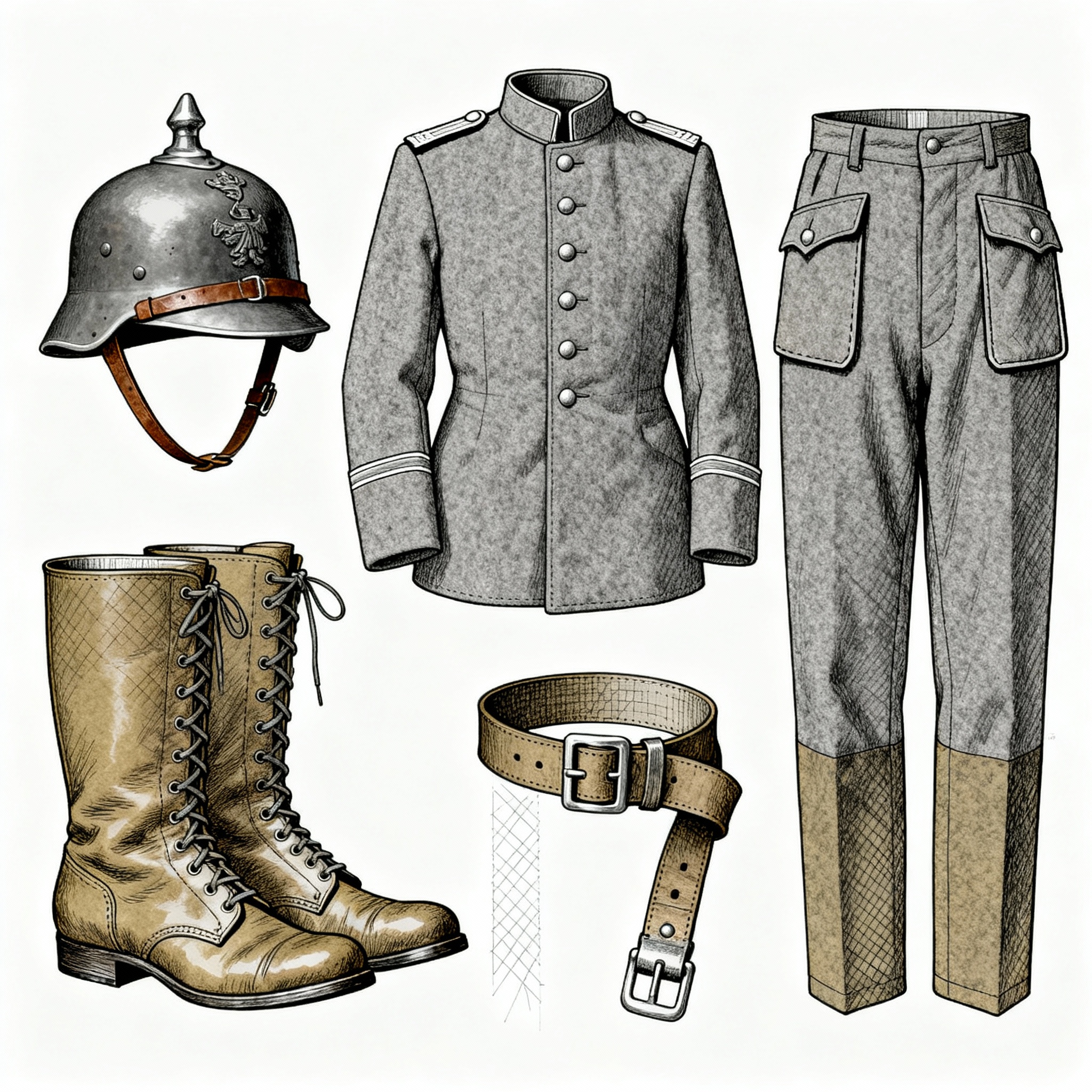
WW2 Uniform Guide: Breaking Down WW1 German Uniform Parts for History Buffs
Published on Oct 02, 2025
Did You Know Over 20 Million Soldiers Wore Uniforms in WW1 Alone?
That’s right—over 20 million soldiers across all fronts were issued military uniforms during World War I. Among the most iconic were the German uniforms, known for their discipline-driven design and now cherished by collectors, historians, and reenactors worldwide.
Whether you're a beginner looking to purchase your first piece, a reenactor, or someone diving into WW2 uniforms and historical militaria, this guide will walk you through:
- WW1 German uniform components
- How they evolved into WW2 styles
- Buying authentic gear like WW2 USMC uniforms for sale
- Pitfalls to avoid
- Modern collecting trends (e.g., Bundeswehr outdoor gear)
Let’s begin your journey into the wardrobe of history.
WW1 German Uniform Parts: What Made Them Unique?
1. The Tunic (Feldbluse)
The German Feldbluse was the heart of the WW1 uniform.
Key Features:
- Stand-and-fall collar
- Prussian blue to field gray (Feldgrau) evolution
- Colored piping for unit identification
- Brass or nickel buttons
Collector Tip: Look for tunics with original manufacturer stamps or wartime dates sewn into the lining. Historians and museums highly value these.
2. The Pickelhaube (Spiked Helmet)
Perhaps the most iconic WW1 German headgear, the Pickelhaube had a sharp, pointed top and was later replaced by the Stahlhelm for better protection.
Beware of Fakes: Many replicas are made with plastic or incorrect insignia. Authentic ones are leather-based, with regiment-specific badges.
3. Trousers and Puttees
German soldiers wore stone-grey wool trousers, paired with puttees (leg wraps). They may look simple, but the type of wool and stitching tells a lot about authenticity.
Actionable Tip: Check inner seams and button fly areas for repairs — this indicates genuine field use.
4. Field Gear and Accessories
Items included:
- Bread bag
- Canteen with felt cover
- Mess kit
- Bayonet and frog
Most collectors underestimate the value of these “extras.” Yet full kits can fetch more than individual pieces!
How WW1 Gear Influenced the WW2 Uniform
WW1 uniforms laid the groundwork for WW2 German uniforms and even modern military wear like Bundeswehr outdoor apparel.
Design Shifts:
- Color changes: From gray-green to darker shades
- Cut changes: More practical and mass-producible
- Material upgrades: Use of synthetic dyes and thread
The Hitler Outfit: A Symbolic Uniform
The term "Hitler outfit" often refers to the Nazi Party brown shirt and WW2 officer tunic worn by Hitler and high-ranking Nazi officials. While historically important, these items are controversial and should be approached with educational intent and sensitivity.
WW2 Uniform Market Trends and Buying Tips
1. Where to Find WW2 USMC Uniforms for Sale
The U.S. Marine Corps uniforms are among the most collectible, especially the P41 utility shirts and M1941 field jackets.
Top Platforms:
- eBay (watch for reviews and seller ratings)
- Militaria shows
- Historical auctions
- Dedicated online stores
2. Spotting Authentic World War 2 Navy Uniforms for Sale
Navy uniforms stand out for their unique insignia and sailor-cut pants.
Key Authenticity Checks:
- Proper wool weight and weave
- WWII-era tags (often sewn-in or printed)
- Fading and signs of saltwater exposure
3. Collecting Bundeswehr Outdoor Gear
While technically post-WW2, Bundeswehr outdoor gear (used by the modern German military) is durable, affordable, and heavily inspired by earlier German military clothing.
Recommended Items:
- Flecktarn camo jackets
- Mountain boots
- Ponchos and field tarps
They’re a great entry point for beginner collectors or those who want to reenact or camp in vintage military style.
Common Pitfalls When Collecting WW2 Uniforms and WW1 German Gear
1. Falling for Replicas
Many pieces are made to look old but aren’t. Always ask for:
- Provenance or documentation
- Close-up images of stamps or serial numbers
2. Ignoring Context
Don't just buy something because it's labelled “WW2”. Know what unit wore it, where, and why. It makes collecting more meaningful.
3. Overpaying for Incomplete Kits
A single tunic may seem cheap, but restoring a full set costs far more. Start with complete or near-complete kits to save in the long run.
Actionable Steps for Beginners
✔️ Step 1: Start Small
Begin with accessories—belts, canteens, or hats. They're cheaper and easier to authenticate.
✔️ Step 2: Use Forums & Groups
Join Facebook groups, Reddit threads like r/Militaria, or forums like Wehrmacht-Awards.com.
✔️ Step 3: Attend a Militaria Show
You can learn ten times more in one day of handling real gear than from reading online.
✔️ Step 4: Document Everything
Start a logbook for every item:
- Where did you buy it
- Price
- Any documentation or serial numbers
✔️ Step 5: Preserve Properly
Store in dry conditions, avoid sunlight, and use archival-grade storage materials.
Conclusion: Bring the Past to Life Through the WW2 Uniform Legacy
Understanding WW1 German uniform parts opens the door to appreciating the evolution of military design, tactics, and history.
Whether you’re hunting down authentic WW2 USMC uniforms for sale, browsing for a World War 2 navy uniform, or just dipping your toes into Bundeswehr outdoor gear, remember:
It's not just about collecting items—it's about preserving stories.
